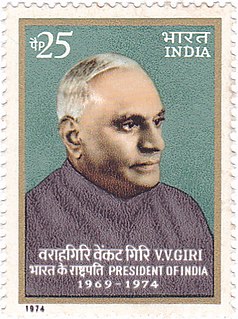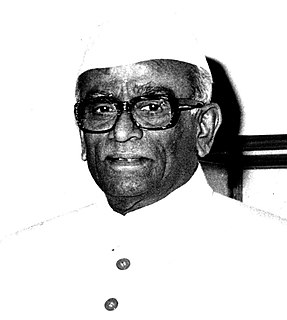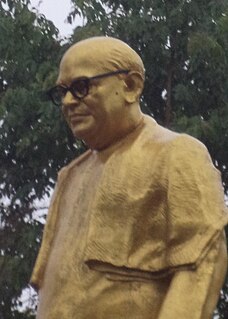
The Indian National Congress(pronunciation ) is a broadly based political party in India. Founded in 1885, it was the first modern nationalist movement to emerge in the British Empire in Asia and Africa. From the late 19th century, and especially after 1920, under the leadership of Mahatma Gandhi, Congress became the principal leader of the Indian independence movement. Congress led India to independence from Great Britain, and powerfully influenced other anti-colonial nationalist movements in the British Empire.

Varahagiri Venkata Giripronunciation (help·info), commonly known as V. V. Giri, was the fourth president of India from 24 August 1969 to 24 August 1974.

The Communist Party of India (Marxist) is the largest communist party in India. The party emerged from a split from the Communist Party of India in 1964. The CPI(M) was formed at the Seventh Congress of the Communist Party of India held in Calcutta from 31 October to 7 November 1964. As of 2018, CPI(M) is leading the state government in Kerala and having elected members in 8 state legislative assemblies including Kerala, West Bengal, Tripura, Himachal Pradesh, Maharashtra, Odisha, Jammu & Kashmir, and Rajasthan. It also leads the West Bengal Left Front. As of 2016, CPI(M) claimed to have 1,048,678 members. The highest body of the party is the Politburo.

The New Patriotic Party (NPP) is a centre-right and liberal conservative party in Ghana. Since the democratization of Ghana in 1992, it has been one of the two dominant parties in Ghana politics; its leading rival being the centre-left National Democratic Congress (NDC). John Kufuor of the NPP was President of Ghana from 2001 to 2009. At the elections held on 7 December 2004, the party won 129 out of 230 seats. The NPP candidate was Kufuor, who was re-elected as President with 52.75% of the vote. The New Patriotic Party symbol is the African elephant and the New Patriotic Party colors are red, white, and blue.

Dravida Munnetra Kazhagam is an Indian state political party in the state of Tamil Nadu and Union Territory of Puducherry. It is a Dravidian party founded by C. N. Annadurai in 1949 as a breakaway faction from the Dravidar Kazhagam headed by Periyar E. V. Ramasamy. DMK was headed by M. Karunanidhi from 1969 until his death on 7 August 2018. He served as Chief Minister of Tamil Nadu five times. DMK was the first party other than the Indian National Congress to win state-level elections with a clear majority on its own in any state in India. The head office of the party is called Anna Arivalayam, which is located at Anna Salai, Teynampet, Chennai, Tamil Nadu.
The Janata Party was an amalgam of Indian political parties opposed to the Emergency that was imposed between 1975 and 1977 by Prime Minister Indira Gandhi of the Indian National Congress. In the 1977 general election, the party defeated the Congress and Janata leader Morarji Desai became the first non-Congress prime minister in independent modern India's history.

The National Federation Party is a Fijian political party founded by A.D. Patel in November 1968, as a merger of the Federation Party and the National Democratic Party. Though it claimed to represent all Fiji Islanders, it was supported, in practice, almost exclusively by Indo-Fijians whose ancestors had come to Fiji, mostly as indentured labourers, between 1879 and 1916.

Neelam Sanjiva Reddypronunciation (help·info) was the sixth President of India, serving from 1977 to 1982. Beginning a long political career with the Indian National Congress Party in the Indian independence movement, he went on to hold several key offices in independent India—as the first Chief Minister of Andhra Pradesh, a two-time Speaker of the Lok Sabha and a Union Minister—before becoming the youngest-ever Indian president.
The Indian National Congress (Organisation) or Congress (O) was a political party in India formed when the Congress party split following the expulsion of Indira Gandhi.

Yashwantrao Balwantrao Chavan was the first Chief Minister of Maharashtra after the division of Bombay State and the fifth Deputy Prime Minister of India. He was a strong Congress leader, co-operative leader, social activist and writer. He was popularly known as Leader of Common People. He advocated social democracy in his speeches and articles and was instrumental in establishing co-operatives in Maharashtra for the betterment of the farmers.

Siddavanahalli Nijalingappa was a senior Congress politician and the Chief Minister of Karnataka between 1956 and 1958 and once again, between 1962 and 1968. He played an important role in the Indian freedom movement as well as in the Karnataka Unification movement.
Veerandra Patil (1924–1997) was a senior Indian politician and was twice, the Chief Minister of Karnataka. He became Chief Minister for the first time from 1968–1971; and the second time was almost 18 years later, from 1989–1990.

General elections were held in India in 1984 soon after the assassination of previous Prime Minister, Indira Gandhi, though the vote in Assam and Punjab was delayed until 1985 due to ongoing fighting.

India held general elections to the 5th Lok Sabha in March 1971. This was the fifth election since independence in 1947. The 27 Indian states and union territories were represented by 518 constituencies, each with a single seat. Under the leadership of Indira Gandhi, the Indian National Congress (R) led a campaign which focussed on reducing poverty and won a landslide victory, overcoming a split in the party and regaining many of the seats lost in the previous election.

General elections were held in India in 1989 to elect the members of the 9th Lok Sabha. V. P. Singh united the entire disparate spectrum of parties including regional parties such as the Telugu Desam Party, the Dravida Munnetra Kazhagam, and the Asom Gana Parishad, forming the National Front with N.T.Rama Rao as President and V. P. Singh as convenor with additional outside support from the Bharatiya Janata Party and Communist Party of India (Marxist) led Left front they defeated Rajiv Gandhi's Congress (I) in the 1989 parliamentary elections.
Pilibhit Lok Sabha constituency is one of the 80 Lok Sabha (parliamentary) constituencies in Uttar Pradesh state in northern India.

The seventh legislative assembly election to Tamil Nadu was held on May 28, 1980. Election was held two years before the end of the term of M. G. Ramachandran administration as it was dissolved by the then President of India Neelam Sanjiva Reddy. Dravida Munnetra Kazhagam allied with the Indian National Congress (Indira) and Anna Dravida Munnetra Kazhagam with Janata Party. Despite their victory at the 1980 Lok Sabha polls, DMK and Indira Congress failed to win the legislative assembly election. ADMK won the election and its leader and incumbent Chief Minister, M. G. Ramachandran was sworn in as Chief Minister for the second time. He became the first leader since K. Kamaraj to win a re-election as a Chief Minister.

The second legislative council election to Madras Presidency after the establishment of dyarchical system of government by the Government of India Act, 1919 was held in 1923. Voter turnout was higher than the previous election. Swarajists, a breakaway group from Indian National Congress participated in the election. The ruling Justice Party had suffered a split, when a splinter group calling themselves anti-Ministerialists left the party. It won the highest number of seats but fell short of a majority. Nevertheless, Madras Governor Willington invited it to form the government. Incumbent Justice chief minister Panagal Raja was nominated by party leader Theagaraya Chetty to continue as chief minister for a second term. The government survived a no-confidence motion, brought against it on the very first day of its tenure by the opposition headed by C. R. Reddy.
The elections to the next Vice-President of India, were held on 5 August 2017. The announcement was made by the Election Commission of India.

















